Development of a Landscape-Based Multi-Metric Index to Assess Wetland Health of the Poyang Lake
Abstract
:1. Introduction
2. Materials and Methods
2.1. Study Area
2.2. Data Collection and Processing
2.3. Candidate Metrics
2.4. Reference Site Selection
2.5. Spatial Scales and Metric Selection
2.6. Metric Scoring and Wetland Health Assessment
2.7. Assessment Result Validation
3. Results
3.1. Land Uses
3.2. Explanatory Power of Landscape and Remote Sensing Variables on IBIs
3.3. Metric Selection
3.4. Wetland Health Assessment
4. Discussion
4.1. Landscape and Remote Sensing Metrics
4.2. Spatial Scales for Wetland Health Assessment
4.3. Wetland Health Assessment in the Poyang Lake
5. Conclusions
Author Contributions
Funding
Institutional Review Board Statement
Informed Consent Statement
Data Availability Statement
Acknowledgments
Conflicts of Interest
References
- Costanza, R.; d’Arge, R.; De Groot, R.; Farber, S.; Grasso, M.; Hannon, B.; Limburg, K.; Naeem, S.; O’neill, R.V.; Paruelo, J. The value of the world’s ecosystem services and natural capital. Nature 1997, 387, 253–260. [Google Scholar] [CrossRef]
- Davidson, N.C. How much wetland has the world lost? Long-term and recent trends in global wetland area. Mar. Freshw. Res. 2014, 65, 934–941. [Google Scholar] [CrossRef]
- Zedler, J.B.; Kercher, S. Wetland resources: Status, trends, ecosystem services, and restorability. Annu. Rev. Environ. Resour. 2005, 30, 39–74. [Google Scholar] [CrossRef] [Green Version]
- Hasan, S.S.; Zhen, L.; Miah, M.G.; Ahamed, T.; Samie, A. Impact of land use change on ecosystem services: A review. Environ. Dev. 2020, 34, 100527. [Google Scholar] [CrossRef]
- Cheng, X.; Chen, L.; Sun, R.; Kong, P. Land use changes and socio-economic development strongly deteriorate river ecosystem health in one of the largest basins in China. Sci. Total Environ. 2018, 616–617, 376–385. [Google Scholar] [CrossRef] [PubMed]
- Xie, X.; Fang, B.; Xu, H.; He, S.; Li, X. Study on the coordinated relationship between Urban Land use efficiency and ecosystem health in China. Land Use Policy 2021, 102, 105235. [Google Scholar] [CrossRef]
- Yu, G.; Yu, Q.; Hu, L.; Zhang, S.; Fu, T.; Zhou, X.; He, X.; Liu, Y.A.; Wang, S.; Jia, H. Ecosystem health assessment based on analysis of a land use database. Appl. Geogr. 2013, 44, 154–164. [Google Scholar] [CrossRef]
- Peng, J.; Liu, Y.; Li, T.; Wu, J. Regional ecosystem health response to rural land use change: A case study in Lijiang City, China. Ecol. Indic. 2017, 72, 399–410. [Google Scholar] [CrossRef]
- Jafary, P.; Sarab, A.A.; Tehrani, N.A. Ecosystem health assessment using a Fuzzy Spatial Decision Support System in Taleghan watershed before and after dam construction. Environ. Process. 2018, 5, 807–831. [Google Scholar] [CrossRef]
- Ruaro, R.; Gubiani, É.A.; Hughes, R.M.; Mormul, R.P. Global trends and challenges in multimetric indices of biological condition. Ecol. Indic. 2020, 110, 105862. [Google Scholar] [CrossRef]
- Stoddard, J.L.; Herlihy, A.T.; Peck, D.V.; Hughes, R.M.; Whittier, T.R.; Tarquinio, E. A process for creating multimetric indices for large-scale aquatic surveys. J. N. Am. Benthol. Soc. 2008, 27, 878–891. [Google Scholar] [CrossRef]
- Ruaro, R.; Gubiani, É.A. A scientometric assessment of 30 years of the Index of Biotic Integrity in aquatic ecosystems: Applications and main flaws. Ecol. Indic. 2013, 29, 105–110. [Google Scholar] [CrossRef]
- Xu, L.; Yang, W.; You, Q.; Yang, T.; Huang, Q.; Wang, Y. The recent advances in applications of index of biotic integrity on the assessment of wetland ecological health. Jiangxi Norm. Univ. (Nat. Sci. Ed.) 2017, 41, 104–109. [Google Scholar]
- Angel Martínez-Morales, M. Landscape patterns influencing bird assemblages in a fragmented neotropical cloud forest. Biol. Conserv. 2005, 121, 117–126. [Google Scholar] [CrossRef]
- Pyne, M.I.; Rader, R.B.; Christensen, W.F. Predicting local biological characteristics in streams: A comparison of landscape classifications. Freshw. Biol. 2007, 52, 1302–1321. [Google Scholar] [CrossRef]
- Hrodey, P.; Sutton, T.; Frimpong, E.; Simon, T. Land-use impacts on watershed health and integrity in Indiana warmwater streams. Am. Midl. Nat. 2009, 161, 76–95. [Google Scholar] [CrossRef]
- Han, X.; Chen, X.; Feng, L. Four decades of winter wetland changes in Poyang Lake based on Landsat observations between 1973 and 2013. Remote Sens. Environ. 2015, 156, 426–437. [Google Scholar] [CrossRef]
- You, Q.; Fang, N.; Jian, M.; Hu, Q.; Yao, B.; Liu, D.; Yang, W. A reliability-resilience-vulnerability framework for measuring the influence of changes in water level fluctuations on lake conditions. Ecol. Indic. 2022, 134, 108468. [Google Scholar] [CrossRef]
- Yang, W.; You, Q.; Fang, N.; Xu, L.; Zhou, Y.; Wu, N.; Ni, C.; Liu, Y.; Liu, G.; Yang, T.; et al. Assessment of wetland health status of Poyang Lake using vegetation-based indices of biotic integrity. Ecol. Indic. 2018, 90, 79–89. [Google Scholar] [CrossRef]
- Li, Y.; Zhang, Q.; Cai, Y.; Tan, Z.; Wu, H.; Liu, X.; Yao, J. Hydrodynamic investigation of surface hydrological connectivity and its effects on the water quality of seasonal lakes: Insights from a complex floodplain setting (Poyang Lake, China). Sci. Total Environ. 2019, 660, 245–259. [Google Scholar] [CrossRef]
- Zhang, Q.; Ye, X.-C.; Werner, A.D.; Li, Y.-L.; Yao, J.; Li, X.-H.; Xu, C.-Y. An investigation of enhanced recessions in Poyang Lake: Comparison of Yangtze River and local catchment impacts. J. Hydrol. 2014, 517, 425–434. [Google Scholar] [CrossRef] [Green Version]
- Zhang, Q.; Xiao, M.; Li, J.; Singh, V.P.; Wang, Z. Topography-based spatial patterns of precipitation extremes in the Poyang Lake basin, China: Changing properties and causes. J. Hydrol. 2014, 512, 229–239. [Google Scholar] [CrossRef]
- Tang, X.; Li, H.; Xu, X.; Yang, G.; Liu, G.; Li, X.; Chen, D. Changing land use and its impact on the habitat suitability for wintering Anseriformes in China’s Poyang Lake region. Sci. Total Environ. 2016, 557–558, 296–306. [Google Scholar] [CrossRef]
- Ye, X.; Zhang, Q.; Bai, L.; Hu, Q. A modeling study of catchment discharge to Poyang Lake under future climate in China. Quat. Int. 2011, 244, 221–229. [Google Scholar] [CrossRef]
- Luo, Z.; Shi, X.; Han, L.; Nie, L. A study on carbon emission effects of changes in land use in poyang lake region. Acta Agric. Univ. Jiangxiensis 2013, 35, 1074–1081. [Google Scholar] [CrossRef]
- Zhong, Y.; Lu, Y. The coupling relationship between population and economic in Poyang Lake ecological economic zone. Econ. Geogr. 2011, 31, 195–200. [Google Scholar] [CrossRef]
- Zhang, X.; Yi, Y.; Yang, Z. The long-term changes in food web structure and ecosystem functioning of a shallow lake: Implications for the lake management. J. Environ. Manag. 2022, 301, 113804. [Google Scholar] [CrossRef]
- He, Y.; Che, T.; Wang, Y. Ecological footprint and endogenous economic growth in the Poyang Lake Area in China based on empirical analysis of panel data model. J. Resour. Ecol. 2012, 3, 367–372. [Google Scholar] [CrossRef]
- Sun, C.; Zhen, L.; Giashuddin Miah, M. Comparison of the ecosystem services provided by China’s Poyang Lake wetland and Bangladesh’s Tanguar Haor wetland. Ecosyst. Serv. 2017, 26, 411–421. [Google Scholar] [CrossRef]
- Herlihy, A.T.; Larsen, D.P.; Paulsen, S.G.; Urquhart, N.S.; Rosenbaum, B.J. Designing a spatially balanced, randomized site selection process for regional stream surveys: The EMAP Mid-Atlantic pilot study. Environ. Monit. Assess. 2000, 63, 95–113. [Google Scholar] [CrossRef]
- Ministry of Environmental Protection of the People’s Republic of China. Standard Methods for the Analysis of Water and Wastewater; China Environmental Science Press: Beijing, China, 2012.
- Shawul, A.A.; Chakma, S. Spatiotemporal detection of land use/land cover change in the large basin using integrated approaches of remote sensing and GIS in the Upper Awash basin, Ethiopia. Environ. Earth Sci. 2019, 78, 141. [Google Scholar] [CrossRef]
- García-Llamas, P.; Suárez-Seoane, S.; Fernández-Guisuraga, J.M.; Fernández-García, V.; Fernández-Manso, A.; Quintano, C.; Taboada, A.; Marcos, E.; Calvo, L. Evaluation and comparison of Landsat 8, Sentinel-2 and Deimos-1 remote sensing indices for assessing burn severity in Mediterranean fire-prone ecosystems. Int. J. Appl. Earth Obs. Geoinf. 2019, 80, 137–144. [Google Scholar] [CrossRef]
- Sun, T.; Lin, W.; Chen, G.; Guo, P.; Zeng, Y. Wetland ecosystem health assessment through integrating remote sensing and inventory data with an assessment model for the Hangzhou Bay, China. Sci. Total Environ. 2016, 566, 627–640. [Google Scholar] [CrossRef]
- Saha, T.K.; Pal, S. Exploring physical wetland vulnerability of Atreyee river basin in India and Bangladesh using logistic regression and fuzzy logic approaches. Ecol. Indic. 2019, 98, 251–265. [Google Scholar] [CrossRef]
- Gupta, S.; Islam, S.; Hasan, M.M. Analysis of impervious land-cover expansion using remote sensing and GIS: A case study of Sylhet sadar upazila. Appl. Geogr. 2018, 98, 156–165. [Google Scholar] [CrossRef]
- Mcgarigal, K.S.; Cushman, S.A.; Neel, M.C.; Ene, E. FRAGSTATS: Spatial Pattern Analysis Program for Categorical Maps. Available online: https://www.fs.usda.gov/treesearch/pubs/3064 (accessed on 4 July 2020).
- Ministry of Environmental Protection of the People’s Republic of China. Environmental Quality Standard for Surface Water (GB3838-2002). Available online: http://mee.gov.cn/ywgz/fgbz/bz/bzwb/shjbh/shjzlbz/200206/W020061027509896672057.pdf (accessed on 15 March 2018).
- Fang, N.; Liu, L.; You, Q.; Tian, N.; Wu, Y.; Yang, W. Effects of land use types at different spatial scales on water quality in Poyang Lake wetland. Environ. Sci. 2019, 40, 5348–5357. [Google Scholar]
- Chen, X.; Zhang, Y.; Zhang, L.; Chen, L.; Lu, J. Distribution characteristic of nitrogen and phosphorus in Lake Poyang during high water period. J. Lake Sci. 2013, 25, 643–648. [Google Scholar]
- Huang, Q.; Gao, J.; Cai, Y.; Yin, H.; Gao, Y.; Zhao, J.; Liu, L.; Huang, J. Development and application of benthic macroinvertebrate-based multimetric indices for the assessment of streams and rivers in the Taihu Basin, China. Ecol. Indic. 2015, 48, 649–659. [Google Scholar] [CrossRef]
- You, Q.; Yang, W.; Jian, M.; Hu, Q. A comparison of metric scoring and health status classification methods to evaluate benthic macroinvertebrate-based index of biotic integrity performance in Poyang Lake wetland. Sci. Total Environ. 2021, 761, 144112. [Google Scholar] [CrossRef] [PubMed]
- Johnson, J.B.; Omland, K.S. Model selection in ecology and evolution. Trends Ecol. Evol. 2004, 19, 101–108. [Google Scholar] [CrossRef] [PubMed]
- Uzarski, D.G.; Burton, T.M.; Cooper, M.J.; Ingram, J.W.; Timmermans, S.T. Fish habitat use within and across wetland classes in coastal wetlands of the five Great Lakes: Development of a fish-based index of biotic integrity. J. Great Lakes Res. 2005, 31, 171–187. [Google Scholar] [CrossRef]
- Barbour, M.; Gerritsen, J.; Griffith, G.; Frydenborg, R.; McCarron, E.; White, J.; Bastian, M. A framework for biological criteria for Florida streams using benthic macroinvertebrates. J. N. Am. Benthol. Soc. 1996, 15, 185–211. [Google Scholar] [CrossRef]
- Vander Laan, J.J.; Hawkins, C.P.; Olson, J.R.; Hill, R.A. Linking land use, in-stream stressors, and biological condition to infer causes of regional ecological impairment in streams. Freshw. Sci. 2013, 32, 801–820. [Google Scholar] [CrossRef] [Green Version]
- Couceiro, S.R.M.; Hamada, N.; Forsberg, B.R.; Pimentel, T.P.; Luz, S.L.B. A macroinvertebrate multimetric index to evaluate the biological condition of streams in the Central Amazon region of Brazil. Ecol. Indic. 2012, 18, 118–125. [Google Scholar] [CrossRef]
- Kaufmann, P.R.; Levine, P.; Robison, E.G.; Seeliger, C.; Peck, D.V. Quantifying Physical Habitat in Wadeable Streams EPA/620/R-99/003; US Environmental Protection Agency: Washington, DC, USA, 1999.
- Ligeiro, R.; Hughes, R.M.; Kaufmann, P.R.; Macedo, D.R.; Firmiano, K.R.; Ferreira, W.R.; Oliveira, D.; Melo, A.S.; Callisto, M. Defining quantitative stream disturbance gradients and the additive role of habitat variation to explain macroinvertebrate taxa richness. Ecol. Indic. 2013, 25, 45–57. [Google Scholar] [CrossRef] [Green Version]
- R Core Team. R: A Language and Environment for Statistical Computing. Available online: https://www.R-project.org/ (accessed on 3 August 2020).
- Bu, H.; Meng, W.; Zhang, Y.; Wan, J. Relationships between land use patterns and water quality in the Taizi River basin, China. Ecol. Indic. 2014, 41, 187–197. [Google Scholar] [CrossRef]
- Tischendorf, L.; Fahrig, L. How should we measure landscape connectivity? Landsc. Ecol. 2000, 15, 633–641. [Google Scholar] [CrossRef]
- Spanowicz, A.G.; Jaeger, J.A. Measuring landscape connectivity: On the importance of within-patch connectivity. Landsc. Ecol. 2019, 34, 2261–2278. [Google Scholar] [CrossRef]
- Zamberletti, P.; Zaffaroni, M.; Accatino, F.; Creed, I.F.; De Michele, C. Connectivity among wetlands matters for vulnerable amphibian populations in wetlandscapes. Ecol. Model. 2018, 384, 119–127. [Google Scholar] [CrossRef]
- Hu, C.; Zhang, P.; Zeng, S.; Zhou, W. The temporal and spatial distribution characteristics of different species Nitrogen in Poyang Lake. J. Jiangxi Norm. Univ. (Nat. Sci. Ed.) 2012, 36, 213–217. [Google Scholar] [CrossRef]
- Crewe, T.L.; Timmermans, S.T. Assessing Biological Integrity of Great Lakes Coastal Wetlands Using Marsh Bird and Amphibian Communities. Project # WETLAND3-EPA-01 Technical Report, Marsh Monitoring Program, Bird Studies Canada 2005. Available online: http://glc.org/wp-content/uploads/2016/10/CWC-Bird-Amphib-IBI-Report.pdf (accessed on 16 July 2020).
- Jovanovska, D.; Swetnam, R.D.; Tweed, F.S.; Melovski, L. Assessing the landscape visual quality of Shar Planina, North Macedonia. Landsc. Ecol. 2020, 35, 2805–2823. [Google Scholar] [CrossRef]
- Pratt, B.; Chang, H. Effects of land cover, topography, and built structure on seasonal water quality at multiple spatial scales. J. Hazard. Mater. 2012, 209, 48–58. [Google Scholar] [CrossRef]
- Sliva, L.; Williams, D.D. Buffer zone versus whole catchment approaches to studying land use impact on river water quality. Water Res. 2001, 35, 3462–3472. [Google Scholar] [CrossRef]
- You, Q.; Fang, N.; Liu, L.; Yang, W.; Zhang, L.; Wang, Y. Effects of land use, topography, climate and socio-economic factors on geographical variation pattern of inland surface water quality in China. PLoS ONE 2019, 14, e0217840. [Google Scholar] [CrossRef] [PubMed]
- Liu, L.; Yang, W.; You, Q.; Jian, M.; Liu, D.; Fang, N.; Yang, T.; Wang, Y.; Peng, Y. Water quality assessment of Poyang Lake wetland using radar-type charts. J. Hydroecol. 2020, 41, 131–138. [Google Scholar]
- Huang, J.; Li, Q.; Pontius, R.G.; Klemas, V.; Hong, H. Detecting the dynamic linkage between landscape characteristics and water quality in a subtropical coastal watershed, Southeast China. Environ. Manag. 2013, 51, 32–44. [Google Scholar] [CrossRef] [PubMed]
- Wu, Y.; Yang, W. Indicators and implementing methods of wetland biodiversity monitoring: Taking Great Lakes coastal wetlands as an example. Biodivers. Sci. 2015, 23, 527–535. [Google Scholar] [CrossRef]
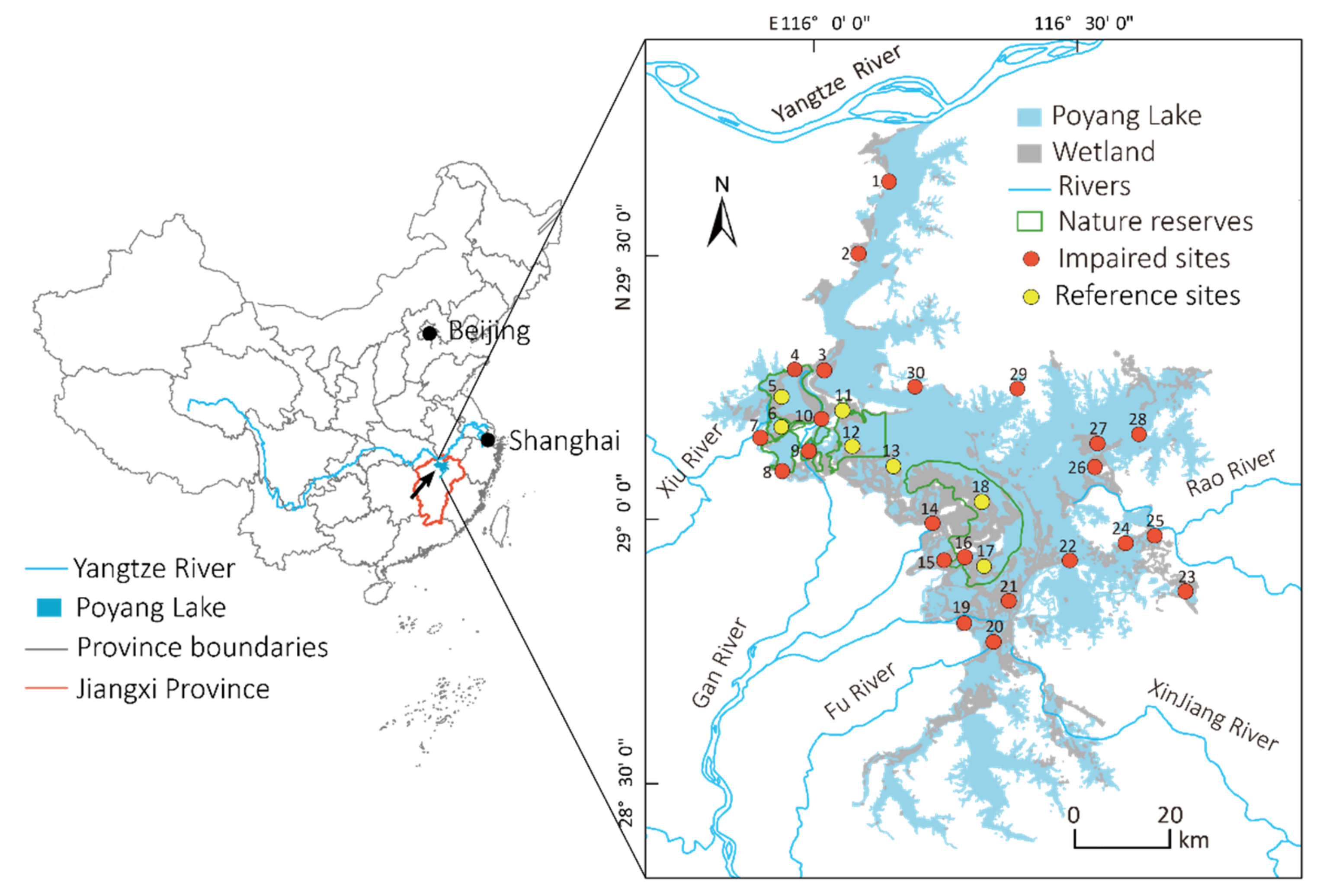

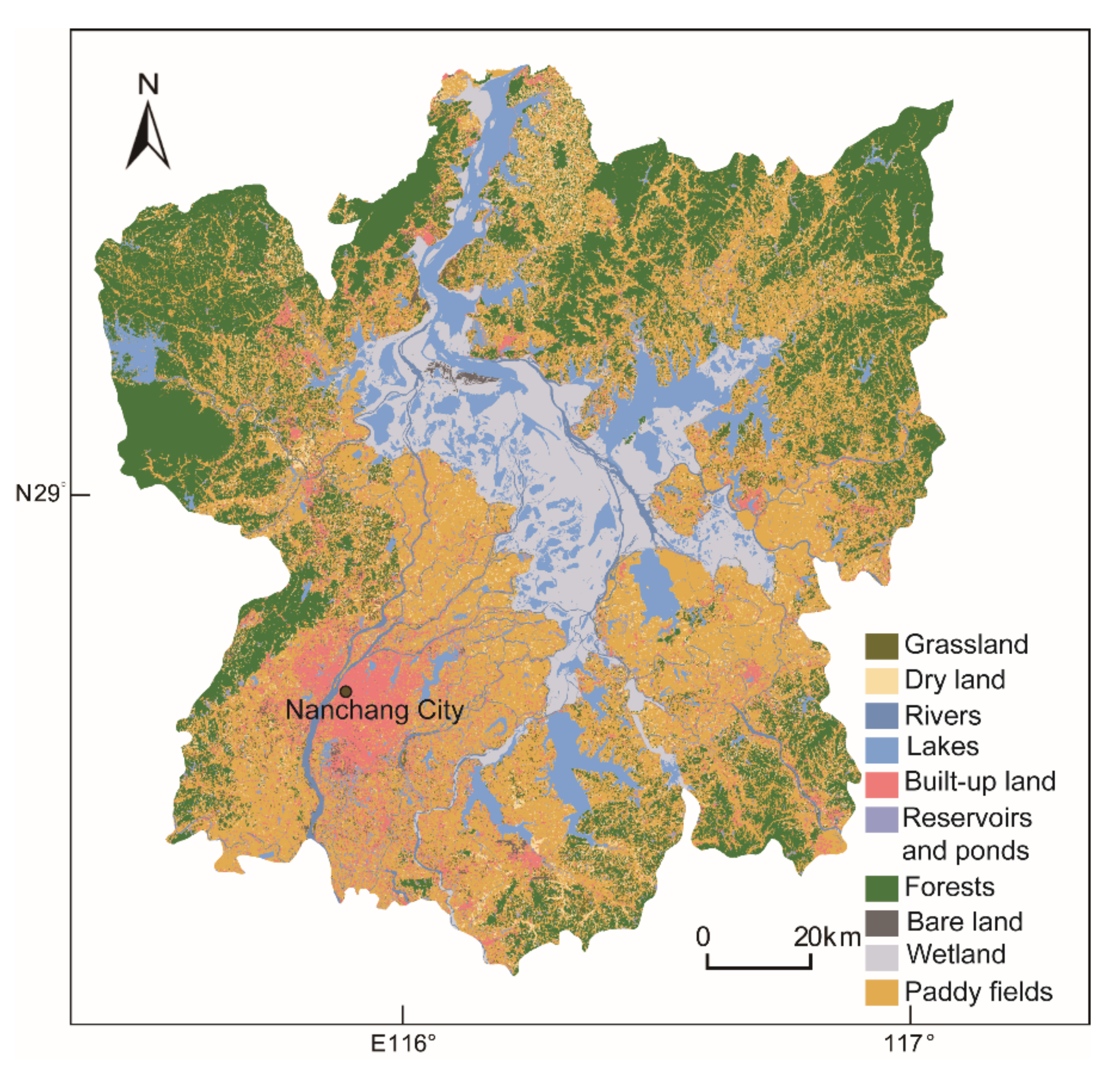
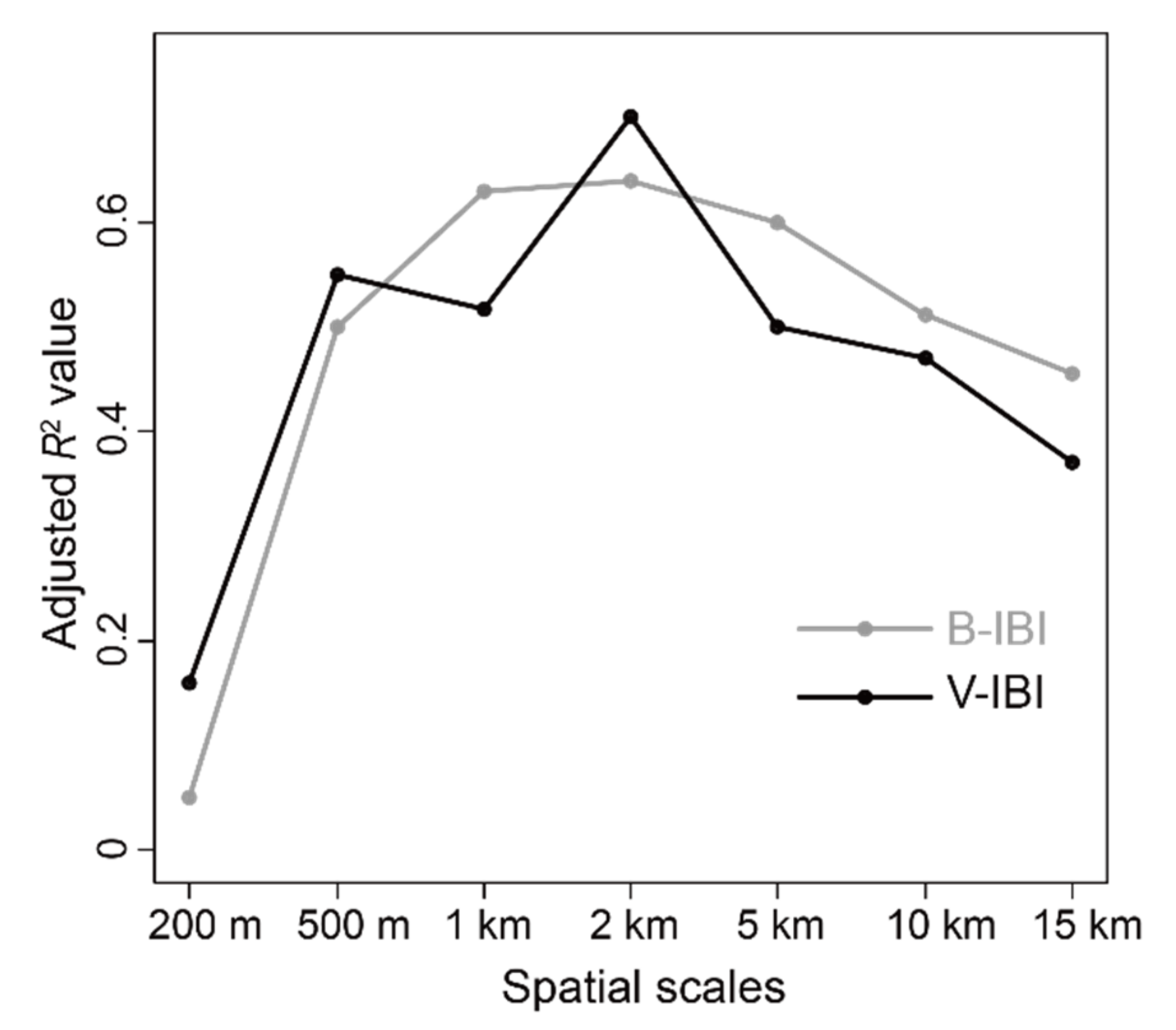
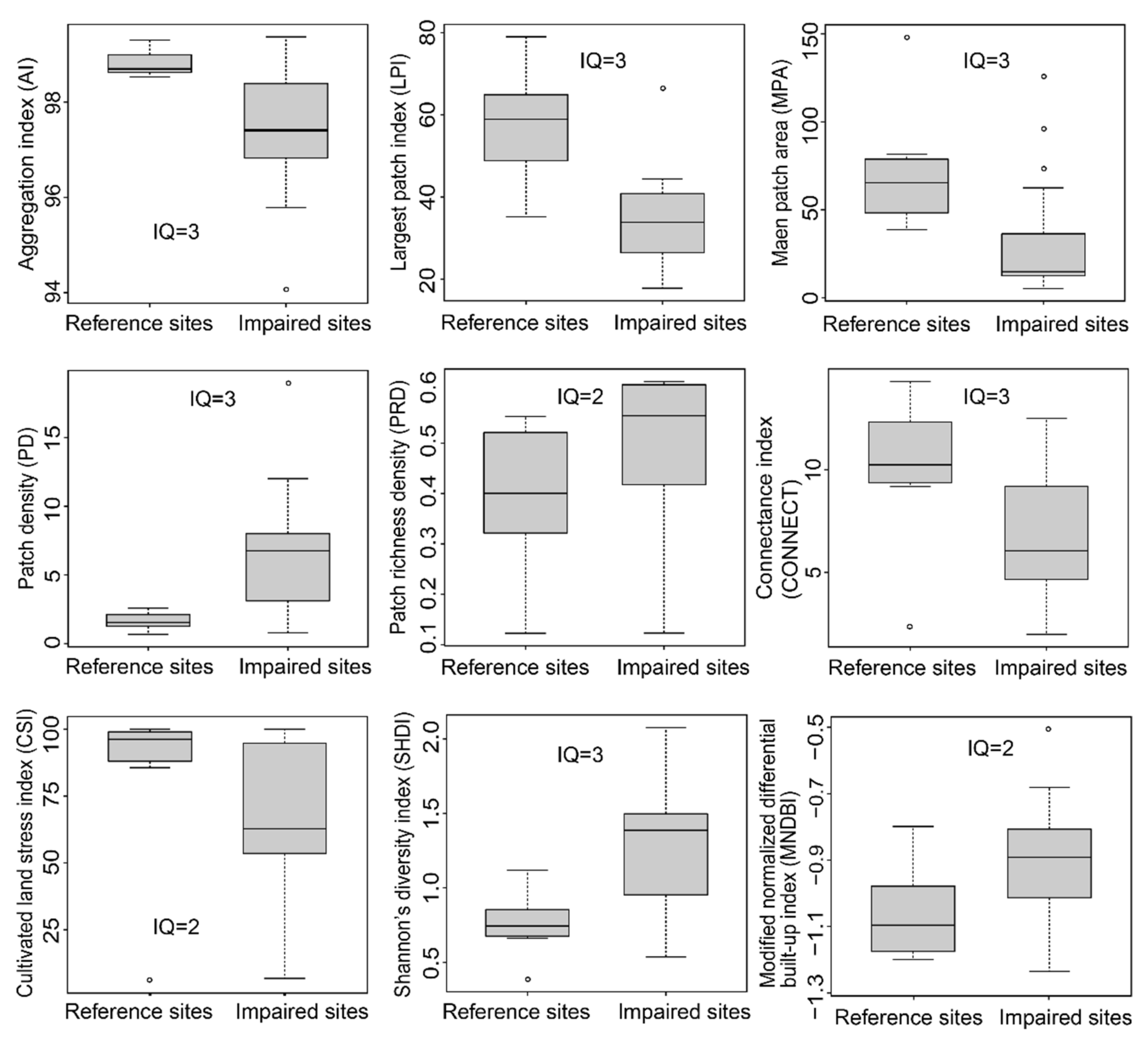
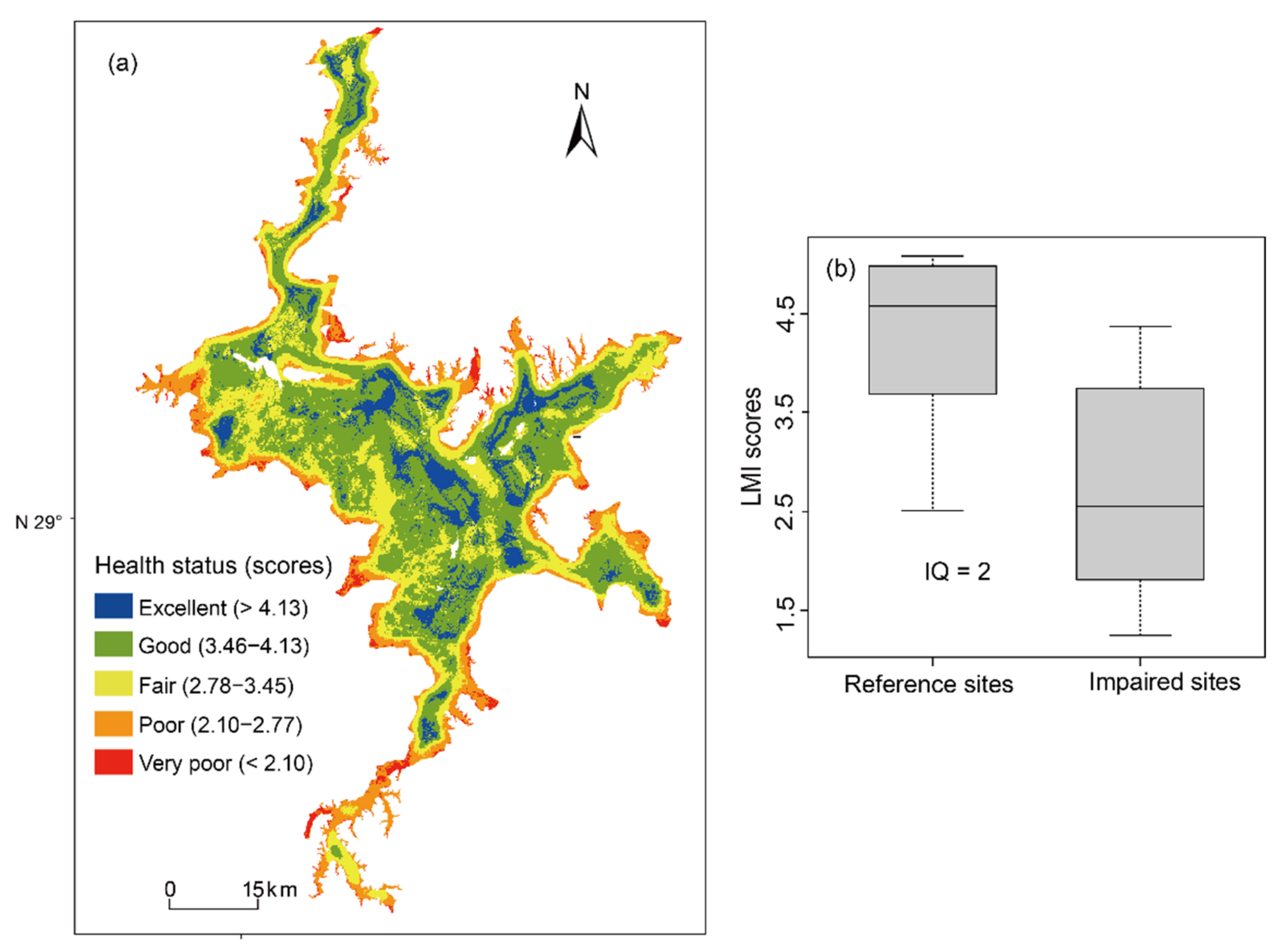

| Number | Landscape and Remote Sensing Metrics (Abbreviation) | Description | Calculation |
|---|---|---|---|
| 1 | Patch richness density (PRD) | Number of patch types per 100 hectares | |
| 2 | Patch density (PD) | Number of patches per 100 hectares | |
| 3 | Patch richness (PR) | Number of patch types | |
| 4 | Mean patch size (AREA_MN) | Mean size of the landscape patch | |
| 5 | Number of patches (NP) | Number of patches of total landscape area | |
| 6 | Patch cohesion index (COHESION) | Connectedness of the corresponding patch type | |
| 7 | Mean patch fractal dimension (FRAC_MN) | Mean perimeter of the landscape patch | |
| 8 | Largest patch index (LPI) | Percent of total area in the largest patch (%) | |
| 9 | Landscape shape index (LSI) | Measures shape regularity of the landscape | |
| 10 | Connectance index (CONNECT) | Measures the functional connectedness of the corresponding patch type | |
| 11 | Contagion index (CONTAG) | Tendency of land use types to be aggregated (%) | |
| 12 | Landscape division index (DIVISION) | Degree of separation of patch types | |
| 13 | Shannon’s diversity index (SHDI) | Patch diversity | |
| 14 | Aggregation index (AI) | Tendency of a particular land use type to be aggregated | |
| 15 | Landscape development intensity index (LDI) | Measures the anthropological pressures of the corresponding area | |
| 16 | Shannon’s evenness index (SHEI) | Measures the relative abundance of different patch types | |
| 17 | Hydrological regulation index (HRI) | Percentage of lake, river, ponds, and wetland of the corresponding land use area | - |
| 18 | Cultivated land stress index (CSI) | Percentage of paddy field and dry land of the corresponding land use area | - |
| 19 | Building pressure index (BPI) | Percentage of built land of the corresponding land use area | - |
| 20 | Normalized differential vegetation index (NDVI) | Scaled measurement of density and intensity of green vegetation growth in satellite image | |
| 21 | Modified normalized difference water index (MNDWI) | Measures water body and wetland presence in the corresponding area | |
| 22 | Modified normalized differential built-up index (MNDBI) | Measures the impervious land cover of the corresponding area | |
| 23 | Normalized differential built-up index (NDBI) | Measures urban area of the corresponding area |
| PD | NP | FRAC_MN | LPI | PRD | PR | |
| B-IBI | −0.42 | −0.42 | 0.32 | 0.44 | −0.22 | −0.22 |
| V-IBI | −0.52 | −0.52 | 0.07 | 0.51 | −0.47 | −0.46 |
| AREA_MN | LSI | CONTAG | CONNECT | COHESION | DIVISION | |
| B-IBI | 0.39 | −0.37 | 0.17 | 0.37 | 0.43 | −0.33 |
| V-IBI | 0.52 | −0.49 | 0.18 | 0.58 | 0.53 | −0.51 |
| SHEI | SHDI | AI | HRI | CSI | BPI | |
| B-IBI | −0.16 | −0.48 | 0.36 | 0.32 | −0.46 | −0.34 |
| V-IBI | −0.21 | −0.56 | 0.40 | 0.27 | −0.48 | −0.54 |
| LDI | NDBI | NDVI | MNDBI | MNDWI | - | |
| B-IBI | −0.41 | −0.32 | 0.04 | −0.39 | 0.23 | - |
| V-IBI | −0.43 | −0.23 | 0.11 | −0.41 | 0.18 | - |
| PD | LPI | AREA_MN | CONNECT | PRD | SHDI | AI | CSI | MNDBI | |
|---|---|---|---|---|---|---|---|---|---|
| PD | 1.00 | - | - | - | - | - | - | - | - |
| LPI | −0.47 | 1.00 | - | - | - | - | - | - | - |
| AREA_MN | −1.00 | 0.47 | 1.00 | - | - | - | - | - | - |
| CONNECT | −0.59 | 0.18 | 0.59 | 1.00 | - | - | - | - | - |
| PRD | 0.81 | −0.40 | −0.81 | −0.41 | 1.00 | - | - | - | - |
| SHDI | 0.82 | −0.65 | −0.82 | −0.43 | 0.71 | 1.00 | - | - | - |
| AI | −0.95 | 0.53 | 0.95 | 0.51 | −0.77 | −0.82 | 1.00 | - | - |
| CSI | 0.76 | −0.26 | −0.76 | −0.63 | 0.76 | 0.60 | −0.67 | 1.00 | - |
| MNDBI | 0.52 | −0.18 | −0.52 | −0.57 | 0.34 | 0.37 | −0.46 | 0.43 | 1.00 |
Publisher’s Note: MDPI stays neutral with regard to jurisdictional claims in published maps and institutional affiliations. |
© 2022 by the authors. Licensee MDPI, Basel, Switzerland. This article is an open access article distributed under the terms and conditions of the Creative Commons Attribution (CC BY) license (https://creativecommons.org/licenses/by/4.0/).
Share and Cite
Liu, D.; Liu, L.; You, Q.; Hu, Q.; Jian, M.; Liu, G.; Cong, M.; Yao, B.; Xia, Y.; Zhong, J.; et al. Development of a Landscape-Based Multi-Metric Index to Assess Wetland Health of the Poyang Lake. Remote Sens. 2022, 14, 1082. https://doi.org/10.3390/rs14051082
Liu D, Liu L, You Q, Hu Q, Jian M, Liu G, Cong M, Yao B, Xia Y, Zhong J, et al. Development of a Landscape-Based Multi-Metric Index to Assess Wetland Health of the Poyang Lake. Remote Sensing. 2022; 14(5):1082. https://doi.org/10.3390/rs14051082
Chicago/Turabian StyleLiu, Dandan, Lingling Liu, Qinghui You, Qiwu Hu, Minfei Jian, Guihua Liu, Mingyang Cong, Bo Yao, Ying Xia, Jie Zhong, and et al. 2022. "Development of a Landscape-Based Multi-Metric Index to Assess Wetland Health of the Poyang Lake" Remote Sensing 14, no. 5: 1082. https://doi.org/10.3390/rs14051082
APA StyleLiu, D., Liu, L., You, Q., Hu, Q., Jian, M., Liu, G., Cong, M., Yao, B., Xia, Y., Zhong, J., & Yang, W. (2022). Development of a Landscape-Based Multi-Metric Index to Assess Wetland Health of the Poyang Lake. Remote Sensing, 14(5), 1082. https://doi.org/10.3390/rs14051082






